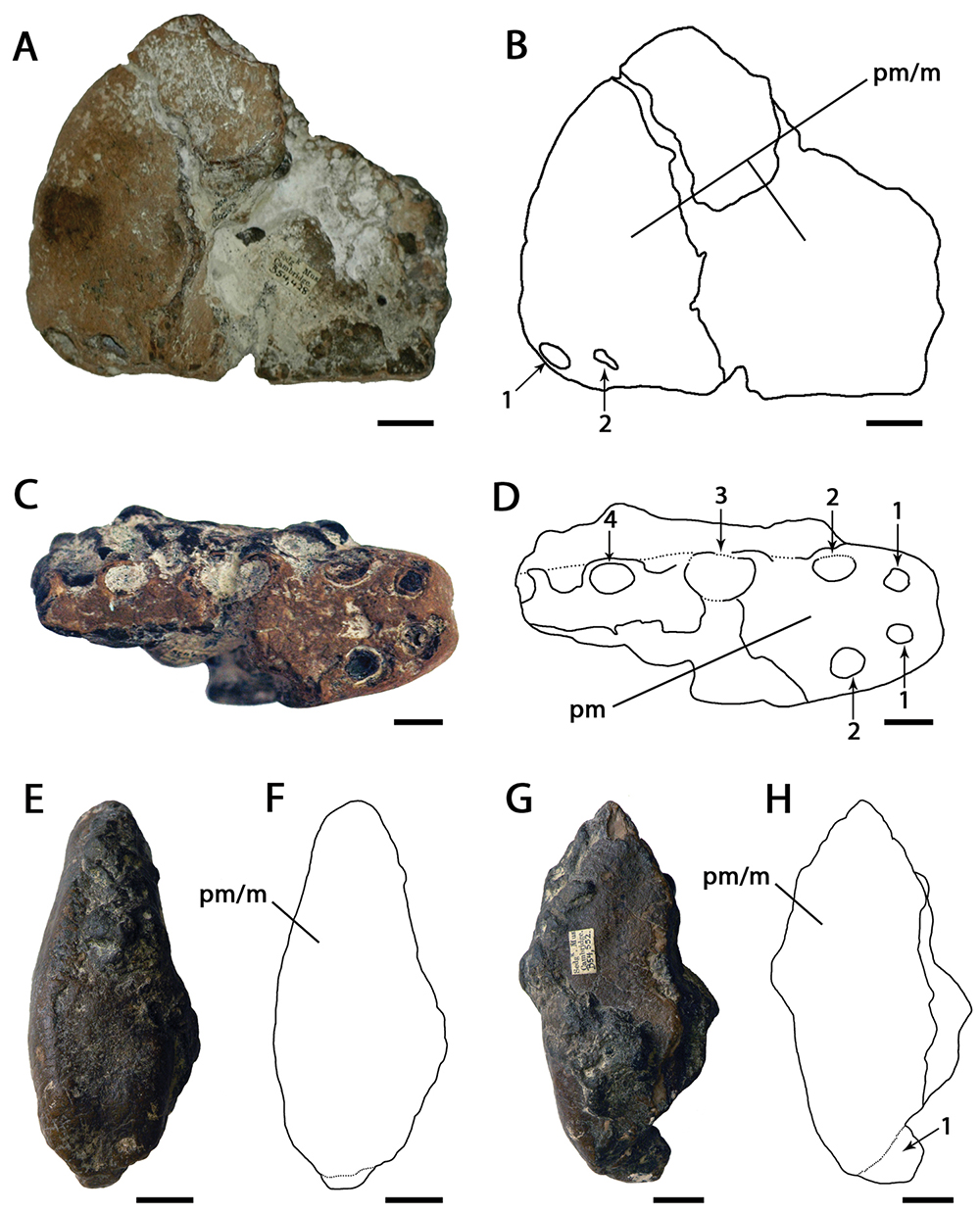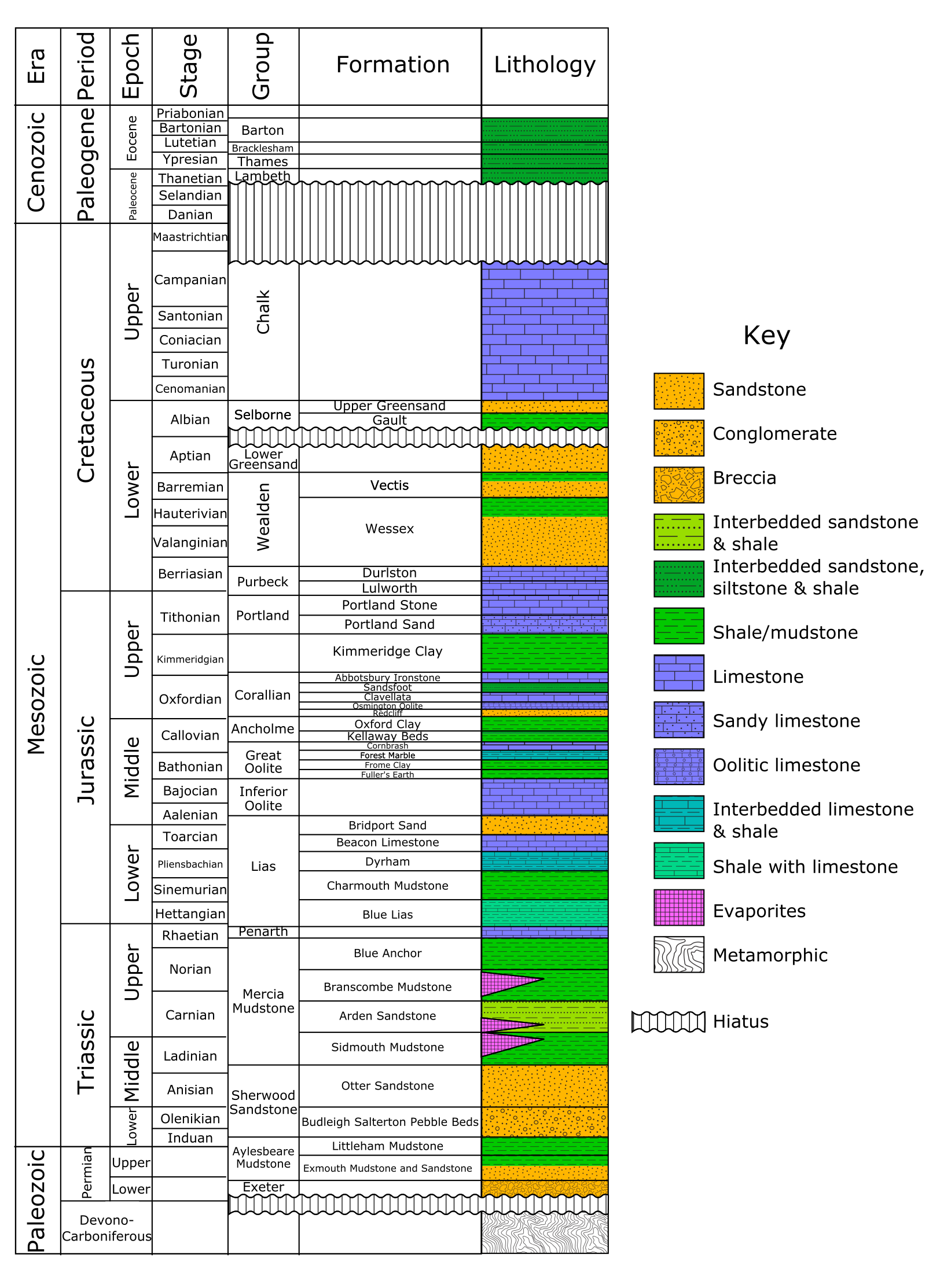|
Caulkicephalus
''Caulkicephalus'' is a genus of anhanguerid pterosaur from the Isle of Wight off the coast of England. It lived during the Early Cretaceous period, about 130 million years ago. Discovery and naming Between 1995 and 2003, bone fragments of an unknown pterosaur were found at the Yaverland locality near Sandown. The discoveries were made in or from a brown clay layer from the Wessex Formation of the Wealden Group, stemming from the Early Cretaceous (Barremian age, about 130 million years ago). In 2005 a new genus was named and described by Lorna Steel, David Martill, David Unwin and John Winch. The type species is ''Caulkicephalus trimicrodon''. The genus name is a translation of "Caulkhead", a traditional nickname for Isle of Wight residents, partially derived from Greek ''kephale'', "head". The specific name, ''trimicrodon'', means "three small teeth", in reference to the dentition. Description The holotype is IWCMS 2002.189.1, 2, 4: three pieces, more or less contiguou ... [...More Info...] [...Related Items...] OR: [Wikipedia] [Google] [Baidu] |
Caulkicephalus Size Chart
''Caulkicephalus'' is a genus of anhanguerid pterosaur from the Isle of Wight off the coast of England. It lived during the Early Cretaceous period, about 130 million years ago. Discovery and naming Between 1995 and 2003, bone fragments of an unknown pterosaur were found at the Yaverland locality near Sandown. The discoveries were made in or from a brown clay layer from the Wessex Formation of the Wealden Group, stemming from the Early Cretaceous (Barremian age, about 130 million years ago). In 2005 a new genus was named and described by Lorna Steel, David Martill, David Unwin and John Winch. The type species is ''Caulkicephalus trimicrodon''. The genus name is a translation of "Caulkhead", a traditional nickname for Isle of Wight residents, partially derived from Greek ''kephale'', "head". The specific name, ''trimicrodon'', means "three small teeth", in reference to the dentition. Description The holotype is IWCMS 2002.189.1, 2, 4: three pieces, more or less contiguous, of ... [...More Info...] [...Related Items...] OR: [Wikipedia] [Google] [Baidu] |
Ornithocheiridae
Ornithocheiridae (or ornithocheirids, meaning "bird hands") is a group of pterosaurs within the suborder Pterodactyloidea. These pterosaurs were among the last to possess teeth. Members that belong to this group lived from the Early to Late Cretaceous periods (Valanginian to Turonian stages), around 140 to 90 million years ago. Ornithocheirids are generally infamous for having an enormously controversial and very confusing taxonomy. Although agreements that these animals were related, and therefore similar to istiodactylids and pteranodontians, there is still no virtual consensus over the exact content and interrelationships of this group. Ornithocheirids were the most successful pterosaurs during their reign, they were also the largest pterosaurs before the appearance of the azhdarchids such as ''Quetzalcoatlus''. Ornithocheirids were excellent fish hunters, they used various flight techniques to catch their prey, and they are also capable of flying great distances without fl ... [...More Info...] [...Related Items...] OR: [Wikipedia] [Google] [Baidu] |
Wessex Formation
The Wessex Formation is a fossil-rich English geological formation that dates from the Berriasian to Barremian stages (about 145–125 million years ago) of the Early Cretaceous. It forms part of the Wealden Group and underlies the younger Vectis Formation and overlies the Durlston Formation. The dominant lithology of this unit is mudstone with some interbedded sandstones. It is part of the strata of the Wessex Basin, exposed in both the Isle of Purbeck and the Isle of Wight. While the Purbeck sections are largely barren of vertebrate remains, the Isle of Wight sections are well known for producing the richest and most diverse fauna in Early Cretaceous Europe. Nomenclatural History The Wessex Formation has historically alternately been called the "Variegated Marls And Sandstones", a name used by W. J. Arkell in his 1947 map of the Isle of Purbeck as well as the "Wealden Marls" It was given its current formal name by Daley and Stewart in 1979 Stratigraphy and Lithology In ... [...More Info...] [...Related Items...] OR: [Wikipedia] [Google] [Baidu] |
Ornithocheiroidea
Ornithocheiroidea (or ornithocheiroids) is a group of pterosaurs within the extinct suborder Pterodactyloidea. They were typically large pterosaurs that lived from the Early to Late Cretaceous periods (Valanginian to Maastrichtian stages), with fossil remains found all over the world except Antarctica. Ornithocheiroids were the most advanced group of pterosaurs, as the group includes the clade Azhdarchoidea, of which its members lived until the Maastrichtian stage of the Late Cretaceous, around 66 million years ago. Notable pterosaurs from this group include the pteranodontians ''Pteranodon'' and ''Nyctosaurus'', the ornithocheirid ''Ornithocheirus'', the anhanguerid ''Tropeognathus'', as well as the azhdarchids ''Hatzegopteryx'' and ''Quetzalcoatlus''. Classification The name Ornithocheiroidea was originally defined as an apomorphy-based taxon by Christopher Bennett in 1994. It was given a relationship-based definition in 2003 by Alexander Kellner, who defined it as the least in ... [...More Info...] [...Related Items...] OR: [Wikipedia] [Google] [Baidu] |
Anhanguerid
Anhangueridae is a group of pterosaurs within the suborder Pterodactyloidea. They were among the last pterosaurs to possess teeth. A recent study discussing the group considered the Anhangueridae to be typified by a premaxillary crest and a lateral expansion in the distal rostrum. The same study presented a cladistic analysis, for which an "agreement subtree" was calculated. The Anhangueridae was found to be sister taxon to the large crested ''Tropeognathus''. Relationships There are competing theories of ornithocheiromorph phylogeny (evolutionary relationships). Below is cladogram following a topology recovered by Brian Andres, using the most recent iteration of his data set. The cladogram below follows Pêgas ''et al.'' (2019), who recovered Anhangueridae as a much more inclusive group. The analysis found most of the ornithocheirids falling into this family, while ''Ornithocheirus'' itself was recovered as a basal member of Ornithocheirae Ornithocheirae is an extinct clad ... [...More Info...] [...Related Items...] OR: [Wikipedia] [Google] [Baidu] |
Yaverland
Yaverland is a village on the Isle of Wight, just north of Sandown on Sandown Bay. It has about 200 houses. About of a mile away from the village is the Yaverland Manor and Church. Holotype fossils have been discovered here of ''Yaverlandia'' and a pterosaur, ''Caulkicephalus''. The White Air extreme sports festival was held annually at Yaverland pay and display car park between 1997 and 2008, but moved to Brighton for 2009. The older part of the village is spread along the road to Bembridge by the Norman Church. The newer part is along the seafront, consisting entirely of a bungalow estate. The name appears to come from a local rendition of "over land" - being the land over the once-tidal causeway. An alternative derivation is from "Yar Island". In the fields below Yaverland the archaeological television programme ''Time Team'' discovered a Roman smithy. In 1545 a battle took place in Yaverland between French forces and local levies. The French were crossing Culver Do ... [...More Info...] [...Related Items...] OR: [Wikipedia] [Google] [Baidu] |
Quadrate Bone
The quadrate bone is a skull bone in most tetrapods, including amphibians, sauropsids (reptiles, birds), and early synapsids. In most tetrapods, the quadrate bone connects to the quadratojugal and squamosal bones in the skull, and forms upper part of the jaw joint. The lower jaw articulates at the articular bone, located at the rear end of the lower jaw. The quadrate bone forms the lower jaw articulation in all classes except mammals. Evolutionarily, it is derived from the hindmost part of the primitive cartilaginous upper jaw. Function in reptiles In certain extinct reptiles, the variation and stability of the morphology of the quadrate bone has helped paleontologists in the species-level taxonomy and identification of mosasaur squamates and spinosaurine dinosaurs. In some lizards and dinosaurs, the quadrate is articulated at both ends and movable. In snakes, the quadrate bone has become elongated and very mobile, and contributes greatly to their ability to swallow very ... [...More Info...] [...Related Items...] OR: [Wikipedia] [Google] [Baidu] |
Jugal
The jugal is a skull bone found in most reptiles, amphibians and birds. In mammals, the jugal is often called the malar or zygomatic. It is connected to the quadratojugal and maxilla, as well as other bones, which may vary by species. Anatomy The jugal bone is located on either side of the skull in the circumorbital region. It is the origin of several masticatory muscles in the skull. The jugal and lacrimal bones are the only two remaining from the ancestral circumorbital series: the prefrontal, postfrontal, postorbital, jugal, and lacrimal bones. During development, the jugal bone originates from dermal bone. In dinosaurs This bone is considered key in the determination of general traits in cases in which the entire skull has not been found intact (for instance, as with dinosaurs in paleontology). In some dinosaur genera the jugal also forms part of the lower margin of either the antorbital fenestra or the infratemporal fenestra, or both. Most commonly, this bone articu ... [...More Info...] [...Related Items...] OR: [Wikipedia] [Google] [Baidu] |
Wingspan
The wingspan (or just span) of a bird or an airplane is the distance from one wingtip to the other wingtip. For example, the Boeing 777–200 has a wingspan of , and a wandering albatross (''Diomedea exulans'') caught in 1965 had a wingspan of , the official record for a living bird. The term wingspan, more technically extent, is also used for other winged animals such as pterosaurs, bats, insects, etc., and other aircraft such as ornithopters. In humans, the term wingspan also refers to the arm span, which is distance between the length from one end of an individual's arms (measured at the fingertips) to the other when raised parallel to the ground at shoulder height at a 90º angle. Former professional basketball player Manute Bol stood at and owned one of the largest wingspans at . Wingspan of aircraft The wingspan of an aircraft is always measured in a straight line, from wingtip to wingtip, independently of wing shape or sweep. Implications for aircraft design and anima ... [...More Info...] [...Related Items...] OR: [Wikipedia] [Google] [Baidu] |
Early Cretaceous
The Early Cretaceous ( geochronological name) or the Lower Cretaceous (chronostratigraphic name), is the earlier or lower of the two major divisions of the Cretaceous. It is usually considered to stretch from 145 Ma to 100.5 Ma. Geology Proposals for the exact age of the Barremian-Aptian boundary ranged from 126 to 117 Ma until recently (as of 2019), but based on drillholes in Svalbard the defining early Aptian Oceanic Anoxic Event 1a (OAE1a) was carbon isotope dated to 123.1±0.3 Ma, limiting the possible range for the boundary to c. 122–121 Ma. There is a possible link between this anoxic event and a series of Early Cretaceous large igneous provinces (LIP). The Ontong Java-Manihiki-Hikurangi large igneous province, emplaced in the South Pacific at c. 120 Ma, is by far the largest LIP in Earth's history. The Ontong Java Plateau today covers an area of 1,860,000 km2. In the Indian Ocean another LIP began to form at c. 120 Ma, the Kerguelen P ... [...More Info...] [...Related Items...] OR: [Wikipedia] [Google] [Baidu] |
Synapomorphy
In phylogenetics, an apomorphy (or derived trait) is a novel character or character state that has evolved from its ancestral form (or plesiomorphy). A synapomorphy is an apomorphy shared by two or more taxa and is therefore hypothesized to have evolved in their most recent common ancestor. ) In cladistics, synapomorphy implies homology. Examples of apomorphy are the presence of erect gait, fur, the evolution of three middle ear bones, and mammary glands in mammals but not in other vertebrate animals such as amphibians or reptiles, which have retained their ancestral traits of a sprawling gait and lack of fur. Thus, these derived traits are also synapomorphies of mammals in general as they are not shared by other vertebrate animals. Etymology The word —coined by German entomologist Willi Hennig—is derived from the Ancient Greek words (''sún''), meaning "with, together"; (''apó''), meaning "away from"; and (''morphḗ''), meaning "shape, form". Clade analysis T ... [...More Info...] [...Related Items...] OR: [Wikipedia] [Google] [Baidu] |






.jpg)